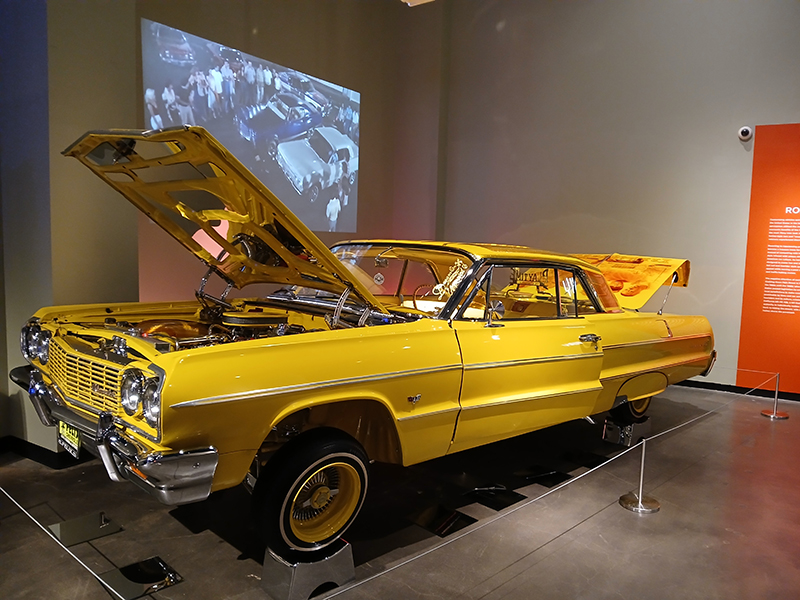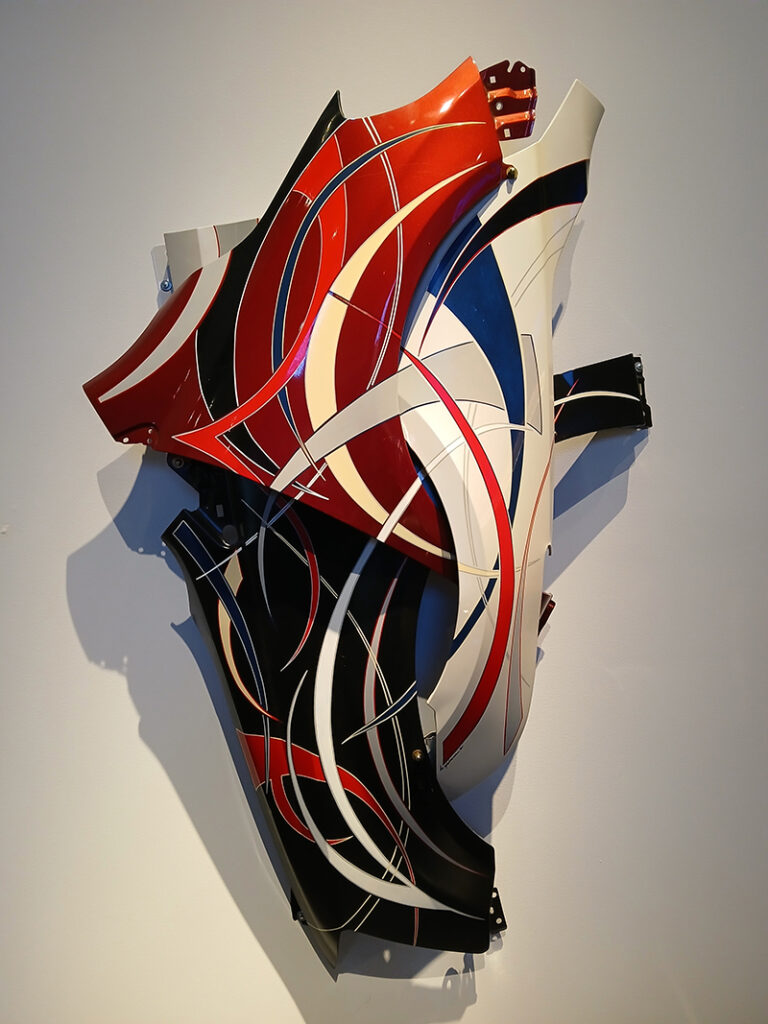
This 1964 Chevy Impala is on display in the ‘Built’ exhibition at Peoria Riverfron Museum courtesy of Bernard Clemons of St. Louis. He designed the automobile to honor the West Coat rappers of the 1990s. The exhibit runs through April 27.
JL SHANNON
“Built: American Custom Car Culture” is on display at the Peoria Riverfront Museum. Co-curators Darius Donaldson and Farai Kasambira, sat down for questions and answers with Community Word reporter JL Shannon to discuss the exhibit, which will be on display through April 27.
Q: How did you pick the cars and, well, everything, not just the cars, the art. What were your criteria for selecting them?
FK: Well, we started because we’ve thrown car events and produced car shows in the area since 2009.
Darius has been building cars for 30-plus years, winning awards and things of that sort.
Though we do our car shows, which started outdoors and are now indoors at the Civic Center, we wanted to place the artful side and the cars in a different light, basically in a museum to showcase how they are pieces of art.
So we came up with the idea for this, starting in 2018 and then we began speaking with John Morris and Bill Conger here at the museum in 2019.
For years it wasn’t even a possibility when we started, because this space was a dedicated IHSA and nature space. But then (during) COVID, they cleared it out.
But we were talking to them throughout the whole time, and went back and forth, and they were encouraging.
Finally, in January of last year, 2024, we signed the deal, and then we began working diligently to create the exhibition along with Everley Davis, the assistant curator here at the museum. She was the head curator, and we were co-curators of the exhibition.
So from there, we began traveling around not just the area, but the region, the country. So we went as far as Indianapolis, Chicago, Louisville, Ky., even Las Vegas, to find cars for the exhibition.
We were asked earlier why we chose the local ones. Well, for two reasons. The first reason is to highlight the talent and the skill and the builds that have been done here in the Peoria area.
And the reason that the exhibition is called “Built: American Custom Car Culture” speaks to the question that you had before in terms of why we picked these specific cars. We wanted to highlight the custom aspect of these cars and how that relates to the American experience. How people, for years, have taken a car that they’ve gotten, either some of them were rusty, some of them were found in barns, some of them were hand-me-downs, and they customized them.
So every piece in this exhibition is a custom car. It’s not just something that’s rolled in like an auto show. So that speaks to the idea of what the difference is, and the creativity, ingenuity and the artful aspect of what people do to these vehicles to make them custom cars and custom art.
Q: And yet, out of thousands of custom cars, you selected these. Why are these special?
DD: We ended up narrowing it down to the local ones because this is going to be the first stop on a touring exhibition that we’re starting. We’re from Peoria, so we decided to start it here and have it in our home museum so that we could highlight it here and then tour the concept around the country to different areas with different builders and things of that sort.
Q: What is it about these cars that landed them in this museum?
FK: They’re the best examples of each specific genre of customization.
Q: You felt that they were just the best of the best?
DD: They’re the best in their class. So what they do is they represent American car culture, and each one represents a different era, genre and style. So that’s how we narrowed it down. That was the criteria.
Q: Do you mind just listing off those genres, styles, whatever?
DD: This represents trucking pretty well. That’s the genre on street trucks. (There’s also) resto mod, hot rod, radical custom, retro custom, low rider, big wheel custom.
The back car (of exhibit) represents a kind of high-end hot rod. So a lot of these cars are already established winners, magazine-cover cars, first-place winners at every show they pull up to. So they already have their credentials and background.

A recycled car fender sculpture, ‘a collage of pinstriping,’ by Brad Grimm of Morton is on display at Peoria Riverfront Museum as part of the ‘Built: American Custom Car Culture’.
JL SHANNON
Q: They have their pedigree.
DD: These are highly pedigreed vehicles. All of them are vetted through that process. So that’s part of the pick process.
Q: They’re already famous in their own right.
DD: Actually, all of them, if they pull in to a gas station, all of them are a show within a show. If they pull up, all traffic stops, everyone gets out, everyone’s taking pictures, talking to them. Each one of these cars can drop in anywhere in the parking lot. And it’s a show on its own.
FK: All of these cars, the people that we have that are the builders, have numerous examples that are to this level, numerous award-winning cars that they’ve built.
Q: So the crafts people are top of the top as well. And what about the artwork? You actually included artwork here. How did you decide which artwork to include?
DD: We sourced a local pinstriper artist named Brad Grimm. So he’s a friend of ours, a friend of the community, and he’s local, but he also has his artwork in his studio in the shop.
It’s a collage of pinstriping, mash up of car parts, and it just fit this exhibit well.
FK: He’s also done work with a lot of these builders who have cars showcased and highlighted here.
DD: The pinstripe is what he focuses on. That’s a lost art.
So he did a demonstration live, and he talked about his background and history and how he got into it, and how he feels about the art scene and the car scene here.
Q: What is the artistry of the pinstripe that’s being lost?
DD: Just doing it, period. Just the art of it, period. He’s got to be almost 70 years old. There was one pinstriper here with him in the audience that might be in his 40s. But after that, there’s no one behind those guys. So when they’re gone, this is gone.
You know, I pinstripe a little bit for myself, but this is going to be a lost art.
So that’s what this exhibit is really for, as well, to inspire the next generation of builders, customizers, artisans, you know, just guys to get into the sport, get intrigued by it, get interested in it, and get into it. So we keep it going, and that’s what we wanted to do. We just want to be ambassadors of the custom culture to facilitate the idea that cars are art as well.

1 comment for “These cars at Riverfront Museum are Artistically Built”
Recent Comments
TEST